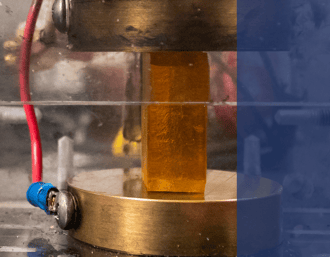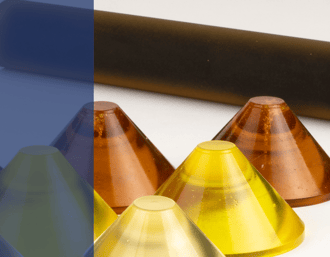Polyurethane Volume Resistivity
Everything in the universe conducts electricity, however, some materials are better at transferring a charge faster than others. Volume resistivity allows products designers to determine how strongly a material resists electrical current. In this post, we will discuss this fundamental physical property and how it can play a role in your polyurethane product design.
What Is Volume Resistivity
Volume resistivity, also known as bulk resistivity or electrical resistivity, is the material’s ability to resist the movement of electricity from one end of the material to the other end. The lower the volume resistivity, the higher the movement and more conductive the material will be.
How to Measure Volume Resistivity

Volume resistivity is reciprocal to conductivity which quantifies the electrical resistance through a material specimen. This process typically involves placing a material specimen between two electrodes and applying a voltage to one electrode and measuring the electrical current through the other electrode. The movement captured between opposing sides equates to volume resistivity, which is measured in ohm’s (Ω). Generally, results will vary depending on the applied voltage and environmental factors. For accurate results, there are several test methods available for product designers to employ, such as ASTM D257.
Electrical Properties of Polyurethanes
Most polyurethanes are insulating materials that naturally fall within a volume resistivity range of 1012 Ωcm to 1015 Ωcm. Due to their chemical structure, the electrical properties of a polyurethane material can be improved by introducing conductive additives during the manufacturing process, such as metal salts similar to Durethane® C. For instance, Durethane® C can be formulated to exhibit resistivities from approximately 105 Ωcm to 1011 Ωcm. To learn more about Durethane® C and what it has to offer your polyurethane product design, click here.How to Use Volume Resistivity in Your Design
 When considering volume resistivity in your design, it is important to understand the level of electrical resistance required. For example, if you are designing a product that requires higher movement below 105Ωcm, some polyurethanes may require significant development work to transfer an electrical charge. This information beforehand can help guide you in your polyurethane manufacturing partner in selecting the appropriate material. Volume resistivity can play an important role in a variety of applications, including medical devices, digital printing & imaging, and electronics.
When considering volume resistivity in your design, it is important to understand the level of electrical resistance required. For example, if you are designing a product that requires higher movement below 105Ωcm, some polyurethanes may require significant development work to transfer an electrical charge. This information beforehand can help guide you in your polyurethane manufacturing partner in selecting the appropriate material. Volume resistivity can play an important role in a variety of applications, including medical devices, digital printing & imaging, and electronics.
If you find volume resistivity is a key performance requirement in your design, this can easily be tailored by your manufacturer. For material assistance, complete our design tool, here, or click the button below to download our Durethane® C material data sheet.





